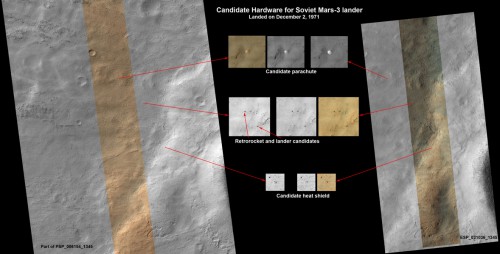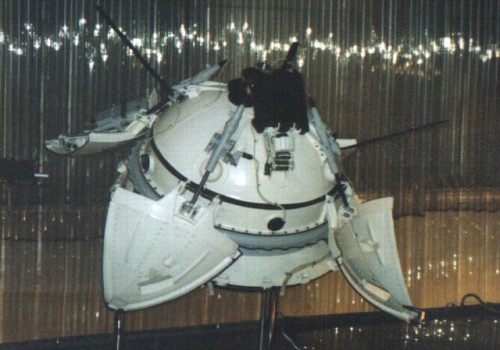
On May 28, 1971, the Soviet Mars 3 spacecraft blasted off from Baikonur atop a Proton-K rocket, just nine days after its sister probe Mars 2. Each consisted of a lander and an orbiter. At 09:14 UT (Universal Time), on Dec. 2, 1971, the Mars 3 descent module separated from the orbiter and began a four-and-a-half-hour journey to the surface of the Red Planet.
The main parts of the 1,210-kilogram descent module were a conical aerodynamic braking shield, a parachute system, retrorockets, and a round capsule, 1.2 meters in diameter, containing the lander.
Plunging into the Martian atmosphere at about 5.7 km/s, the descent module deployed in succession its heat shield aerobrake, parachutes, and retrorockets to achieve the first successful soft-landing on Mars at roughly 45 degrees south, 202 degrees east, in Ptolemaeus Crater.
After touching down, four triangular petals opened, righting the lander and exposing the instrumentation. This was an ambitious spacecraft equipped with a battery of science experiments, a mechanical scoop to collect soil samples to search for organic chemicals and signs of life, and even a small rover on skis which would have glided across the surface while connected to the lander by an umbilical cable. But there was never any chance for this promising equipment to go into action. For 14.5 seconds signals were received from Mars 3, including a partial TV image of 70 lines. Then the transmission stopped, abruptly and permanently. What went wrong—whether it was with the lander (due perhaps to a powerful dust storm taking place at the time) or the communications relay on the orbiter—remains unknown.

And so Mars 3 passed into history—until yesterday when it was announced that in a large image taken in November 2007 by the High Resolution Imaging Science Experiment (HiRISE) camera on NASA’s Mars Reconnaissance Orbiter, the remains of the old spacecraft may have been found. The image, which contains 1.8 billion pixels of data and includes the estimated landing coordinates of the old probe, attracted the attention of Vitali Egorov, who runs a Russian Internet forum devoted to the topic of the new Curiosity rover. Egorov simulated how the major components of Mars 3 ought to appear in a HiRISE image, and then challenged his subscribers to find such features using crowdsourcing. They did, spotting in the southern portion of the scene what looked strikingly like four pieces of the vehicle’s hardware—the parachute, heat shield, retrorocket, and lander. Not only are they the right sizes and shapes, but their arrangement on the surface is consistent with what would be expected from the descent and landing sequence.
To confirm the initial findings, announced at the end of last year, HiRISE investigators were asked to take another detailed image of the region. This they did on March 10, capturing the suspected landing site in color and at a different illumination angle from the earlier shot. The new picture boosts the claim that the features seen are the main elements of Mars 3. A linear feature extending from what appears to be the descent module is possibly the chain by which it was attached to the lander, itself apparently lying close by with its four petals open. An object that appears to be the heat shield partially buried in the surface is also visible.
“I wanted to attract people’s attention to the fact that Mars exploration today is available to practically anyone,” Egorov said. “At the same time we were able to connect with the history of our country, which we were reminded of after many years through the images from the Mars Reconnaissance Orbiter.”
Researchers are cautiously optimistic that further analysis and imaging will remove any doubt that the first successful soft-lander on Mars has been located.
Want to keep up-to-date with all things space? Be sure to “Like” AmericaSpace on Facebook and follow us on Twitter:@AmericaSpace




Quite an interesting find! You will notice that the Soviet Mars landers were beefed up versions of their “Luna” series of lunar landing probes. I wonder if other artifacts can be found (I.e., Vikings 1&2)? Eventually, a human presence on Mars could perform an “Apollo 12-like” retrieval of space hardware!
Or they may become tourist destinations for future Mars colonists!
And remember, this spacecraft was built, launched, and landed in an era when a calculator was called a “slide-rule”.